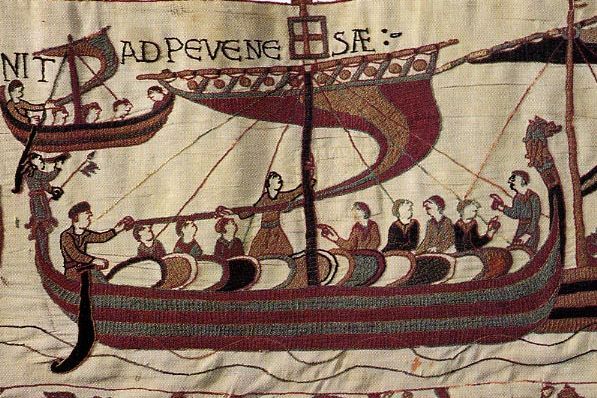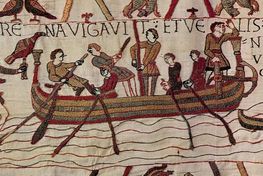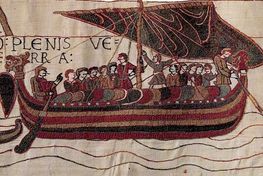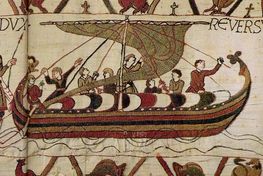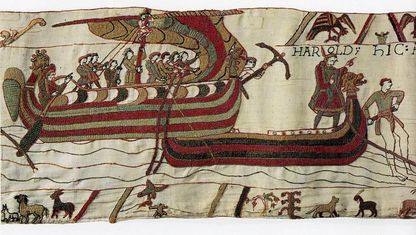
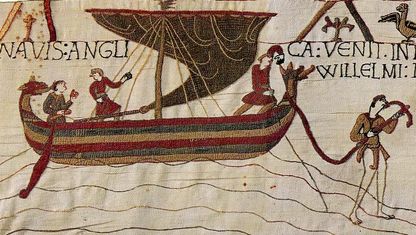
The Bayeux Tapestry
The Bayeux Tapestry is one of the most remarkable picture-sources that has come down to us from medieval Europe. It describes the events leading up to and under William’s conquest of England in 1066 and consists of a 50 cm-wide and 70 m-long embroidered linen frieze. The action takes place in the broad central zone of the frieze, where the individual events are commented on in Latin, generally at the top. Above and below the main zone run two narrow borders, whose pictures are often amplifications of the content of the central part of the frieze.
The origin of the Bayeux Tapestry has been much discussed. The predominant theory today is that it was made in Kent in England at the request of bishop Odo, the half-brother of William the Conqueror, in the course of the 1070s. The arguments in favour of this are first and foremost that the cathedral in Bayeux, to which the tapestry is known to have belonged already in 1476, was in fact built by bishop Odo shortly after the invasion and that three of Odo’s attendants appear and are named in the tapestry. After the invasion Odo was granted extensive lands in Kent and certain Anglo-Saxon features in the Latin text in the tapestry suggests that it can have been composed here. In addition, the colours in the tapestry and its method of production correspond to contemporary English embroidery, which was very popular among reigning European princes in the eleventh century. Other theories name William’s wife, queen Matilda of Flanders, or Edward the Confessor’s wife, queen Edith of Wessex, as possibly being responsible for the work. However that may be, it can be maintained that the content on the tapestry must have been determined in outline shortly after 1066 and that it must have been dictated by people with an extremely good knowledge of the course of events – this is shown by the vast amount of detail in the description, details which are without significance for the historical significance of the account but which can be confirmed by other contemporary sources. For example, there is a quite remarkable figure that decorates the aft-stem of Duke William’s ship: A human figure that is blowing a horn and pointing forward with a lance in his hand. In “William the Conqueror’s ship list”, which is assumed to have been compiled immediately after the invasion, we learn about the duke’s ship that it was a present from his wife Matilda and that she had had its stem decorated with a golden figure of a child whose right hand was pointing to England and whose left hand was pressing an ivory horn to its lips.
Although the Bayeux tapestry is an excellent picture-source, it is not without its pitfalls. The mode of production, the talent of the individual artists and presumably also pressure on the time available for completing the great task have combined to put limitations on the richness and reliability of the details. The individual ship representations are not to be looked upon as naturalistic reproductions but rather as symbols. This already becomes clear in the first ship scenes in the tapestry, where the Englishman Harold Godwinson crosses the channel and lands on the French coast. Harold’s ship is shown four times but with a varying number of strakes in the side of the ship, varying colours in hull and sail and varying stem-decorations.
In the course of the tapestry’s narrative it is also possible to see how the richness of detail in the delineation of the ships gradually diminishes. The rigging is a good example of this. The ships of the English jarl Harold is the first to be shown under sail. Here the sail is shown roughly square-shaped, lifelike folds mark its movements in the wind, both shrouds are indicated and the mast is supported by both fore- and after-stay as well as four shrouds or halyards. On the next picture is shown, similarly vividly, how the sail is hauled down with the halyard and taken in by willing hands. Already the third picture with the sail, however, – where Harold is returning home to England – the picture is simplified. There are still folds in the sail and six supporting ropes to the mast but the sail, which is also here being taken in, is now shown in a characteristic triangular form that henceforward forms the model for the rest of the ship depictions on the tapestry. A little further on in the tapestry an English ship is shown that is carrying the news to William about Harold’s coronation as king. This is the last ship to be shown with other than stylised folds in the sail. In the next – and final – series of pictures of ships under sail it is the invasion fleet that is shown but now with very simplified, triangular sails and with the rigging reduced to two, three or four supporting ropes – only William’s flagship still has six shrouds and stays.
Another place, where the limitations of the tapestry as a source become evident, is in the size of the ships. The ships are depicted as being comparatively short and tall, and the largest number of oar-holes that can be counted on an individual ship is 18 on the ship which is bringing jarl Harold back to England. The ship is delineated as an Anglo-Saxon ship and does not therefore have oar-holes in the middle part of the ship but even so the number is not great in consideration of the fact that Harold was brother-in-law to the king of England, Edward the Confessor, and hence one of England’s mightiest men.
There are presumably several reasons why the artists of the tapestry elected to describe the ships as being shorter than they were in reality. It was first and foremost important for them to show the human-beings involved and these had consequently to be drawn larger than life in comparison with objects such as trees, houses and ships. It can hardly have been desirable to show the ships in their correct proportions, since that would have made the tapestry much longer and the human figures less prominent. Finally, there were limitations as to how small details could be shown, if they were still to be visible when the tapestry was hung up, perhaps in a poorly illuminated church.
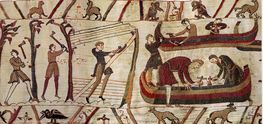
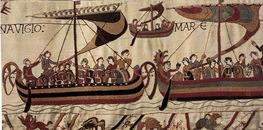
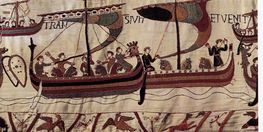
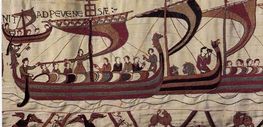
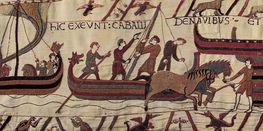
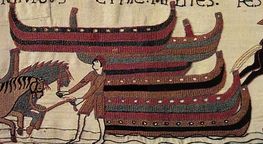
In spite of these problems there is still a large amount of information to be gained from the Bayeux tapestry for those who are interested in the longships of the Viking Age. Harold Godwinson’s longship was clearly different from the Norman ones because on all the pictures it is shown without oars and with one strake fewer in the middle part of the ship. What might be the significance of this we do not know but it is likely that it reflects a real, constructional difference, perhaps even between Anglo-Saxon and Norman-longships.
The shields on the stems of some of the ships and the lantern at MORA’s mast-top reveal how communication took place when a large fleet was to be kept together under an attack. The decoration of the ships – both in the form of the coloured strakes and the ornamentations on the stems – are naturally also recognisable features in the real world. The same also applies to the practice of removing the tops of the stems when the ships are not out sailing, as we can see on the anchored ships with the stem-adornments removed. Among other, surprising, realistic details can be mentioned the tools employed by the boatbuilders in the shipbuilding scenes, which include axes, broadaxes and spoonbits, or the anchor that is dropped out from Harold’s ship – these are delineations that correspond in detail with the archaeological finds from the period.
An interesting question is linked to the way in which the shields are shown, both on Harold’s ships and in the invasion fleet. They do not hang on a shield-rim on the outside of the ship, as they are known to have done from the Viking shipfind Skuldelev 5. Instead they seem to sit inside the ship. On Harold’s ship we can see that they sit fixed and are not simply held by the crew, since these men are busy hauling down the sail. On the Skuldelev 2 reconstruction we have not yet succeeded in finding a satisfactory solution for keeping the shields in place. This is because the distance between the frames is too small – and the Viking-Age shields two big – for an external shield-rim to function properly. Must we instead think about an inside solution?
One of the more surprising elements in the tapestry is that the transport of the army’s horses seems to take place in rowing-ships. It is difficult to believe that a large number of horses could be transported in this way, although it is on the other hand certain that there must have been many horses on the ships – the cavalry was an important part of William’s army. In consideration of the fact that a large number of the ships in the invasion fleet were probably supplied by the harbour-towns on the coast of Normandy, there was probably no shortage of cargo-ships for transporting both the horses and the wooden fort in a do-it-yourself kit that William brought with him – but that those who created the tapestry concentrated on depicting the more resplendent and awe-inspiring warships. When it came to the point, their aim was not to provide us with an accurate body of material but to create an immortal work that would praise the tremendous exploit of William and his vassals!
Danish text: Jan Bill
Translation: Gillian Fellows-Jensen
